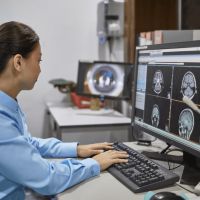Fluid-attenuation inversion recovery (FLAIR) is a commonly-used sequence for estimating the age of an acute ischemic stroke. Timing information is essential for considering intravenous tissue plasminogen activator (tPA) to treat ischaemic stroke. One critical advantage synthetic FLAIR have over conventional FLAIR is its potential to reduce scan times in clinical settings. Deep learning of diffusion-weighted imaging (DWI) can be used to generate synthetic FLAIR images and shorten MRI times. However, the comparatively inferior image quality of synthetic FLAIR images has been a limiting factor that deep learning can address.
French researchers examined data sets including diffusion-weighted imaging and FLAIR sequences from 861 patients obtained within 4.5 hours of acute ischaemic stroke. A deep learning algorithm was trained on 1134 scans and tested on another 282 to produce images that mimicked FLAIR images. The algorithm differed from previous techniques by relying on a generative adversarial network instead of an explicitly acquired MRI signal. Four readers compared the blinded reviews of the synthetic FAIR images to real FLAIR images and found a concordance greater than 80%. Thus, synthetic FLAIR images can be reliably derived from DWI images.
More importantly, the diagnostic value for identifying acute ischaemic stroke did not differ between real and synthetic FLAIR. The researchers could use the synthetic FLAIR images to identify DWI-FLAIR mismatch, an early marker of ischaemic stroke. Synthetic FLAIR showed similar sensitivity and specificity (85% and 92%, respectively) to the real FLAIR images (82% and 92%). Overall, using synthetic instead of real FLAIR imaging may provide a clinically relevant reduction in the time (by 25%) required for stroke MRI protocol acquisition.
Source: Radiology

























